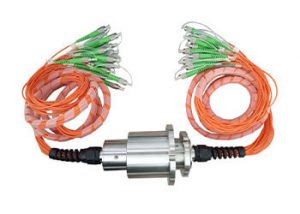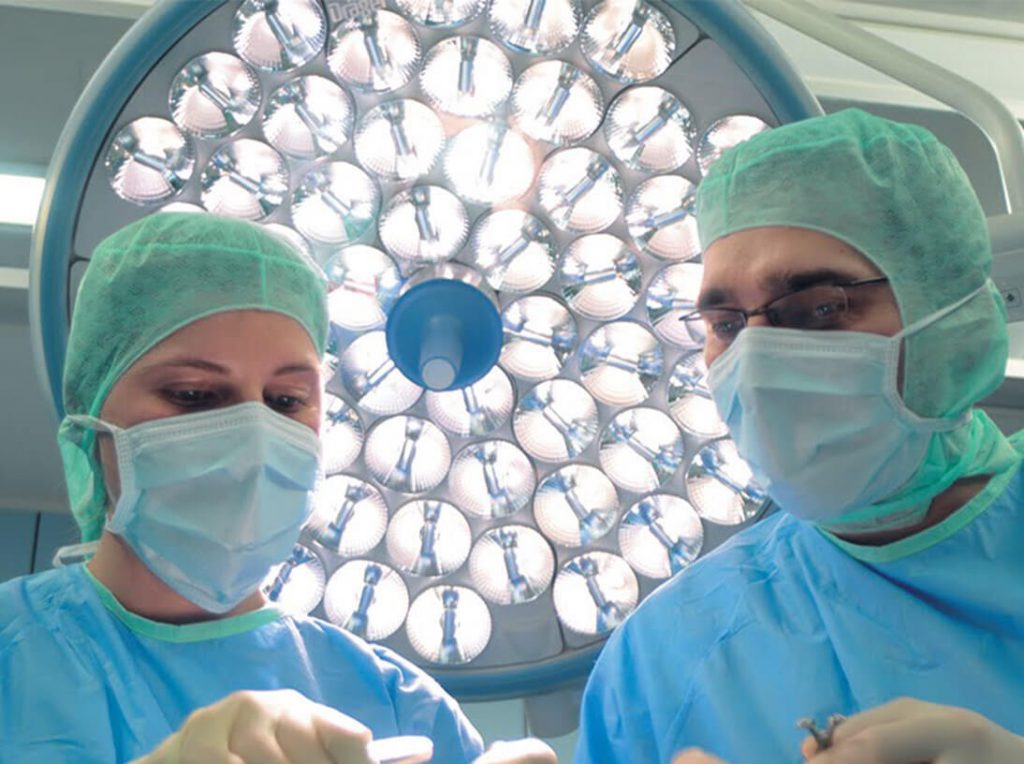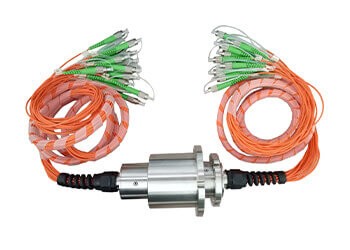Integrated Fiber Optic Rotary Joints (FORJs), also known as fiber optic swivels, are essential components within numerous technological systems that require constant transmission of optical signals across rotating interfaces. These specialized devices enable uninterrupted communication between static and rotating parts without compromising signal fidelity or experiencing signal losses.
Understanding Integrated Fiber Optic Rotary Joints
Fiber Optic Rotary Joints (FORJs) are unique mechanical devices, integrated within fiber optic systems to maintain a consistent and unhindered connection for optical signals as they traverse through a rotating interface. Essentially, FORJs fill the vital role of transmitting light signals between stationary and rotating parts in equipment such as wind turbines, remotely operated vehicles (ROVs), space satellites, and other similar technologies.
Identifying the different types of FORJs is essential to understanding their full capacity and application. Nevertheless, the focus here is on integrated FORJs. While standalone FORJs are designed to be mounted or linked to other components separately, integrated FORJs are specifically manufactured as a part of larger assemblies or systems. This integration provides additional benefits such as reduced size, weight, and easier mounting, which are especially valuable in onboard systems where space and weight are crucial considerations.
The relevance of integrated FORJs in today’s technological landscape cannot be overstated. With the rapid growth of digital communications, the demand for high bandwidth and low signal latency has become a pressing requirement. Ensuring seamless and uninterrupted optical signal transmission across rotating interfaces has been a vital contributing factor in supporting numerous high-speed, data-intensive applications. As technologies continue to advance, the importance of integrated fiber optic rotary joints will only continue to grow, solidifying their significance in modern and future applications.

Applications of Integrated Fiber Optic Rotary Joints
Integrated Fiber Optic Rotary Joints (FORJs) contribute to a multitude of industries, with their versatile applications being an indication of their necessity. They are essential components in telecommunications, data centers, wind turbines, remotely operated vehicles (ROVs), space satellites, broadcasting, medical equipment, robotics, and military systems, among others.
When delving into each application, it becomes clear how integral FORJs are in the operation of these systems. In telecommunications or data centers, FORJs ensure the seamless transmission of data through rotating systems while supporting the high-speed, continuous, and low-loss transfer required by these services. In wind turbines, FORJs are installed in the rotary interface to allow continuous data and video transmission from the control unit to the nacelle that rotates as per wind direction.
In the field of space sciences, satellites employ FORJs for signal transmission between stationary solar panels and constantly moving Earth-facing instruments. Broadcasting and media industries use FORJs in cable reels, mobile antennas, and broadcast towers to ensure uninterrupted HD video/audio transmission.
Medical equipment, such as computerized tomography (CT) scanners, use FORJs for their rotating Gantries, transmitting precise patient data without signal interruptions. Robotics and automated assembly lines use FORJs for multi-axis robotic arms requiring constant data and power transmission. Military applications include tanks, unmanned aerial vehicles (UAVs), and naval ships where FORJs support secure optical communication and radar systems.
The case of wind turbines serves as an insightful real-world example. GE Renewable Energy’s Cypress platform, a next-generation type of wind turbine, employs integrated FORJs to ensure optimal data transmission through rotating structures. Similarly, the military sector’s use of FORJs in UAVs also illustrates their importance. The American MQ-9 Reaper UAVs rely on FORJs for their surveillance systems, connecting stationary control units with rotating optical systems that capture high-definition video and transmit it back to the control unit with no signal loss, despite the UAV’s continuous movement. Thus, FORJs contribute significantly across various industries, enhancing system performance and paving the way for further technological advancements.

Integrated Fiber Optic Rotary Joints: Design and Manufacturing Process
The design and manufacturing process of Integrated Fiber Optic Rotary Joints (FORJs) is an intricate affair, which involves close attention to both mechanical and optical specifications.
The design process begins with defining the specific application’s requirements, which hinges heavily on the mechanical specifications. Some considerations would include the size, weight, necessary rotation speed, and allowable torque of the FORJ; plus the environment in which it will be operated, such as temperature range, pressure, and whether it will be exposed to water or other corrosive elements.
Next come the optical specifications, which include the type of fiber (single mode or multimode), the number of channels required, wavelength band, and optical qualities like insertion loss and return loss.
Once the specifications are defined, engineering design software is used to create a detailed model. Simultaneously, mathematical models are also designed to simulate the optical behavior in terms of signal transmission and reflection. This way, the design can be validated and optimized before proceeding to manufacturing.
In terms of manufacturing, the process typically involves machining the mechanical parts – housings, bearings, and rotating elements – on precision CNC machines. Following this, the optical elements, such as the lens system and fibers, are assembled. Everything is then put together, ensuring the precise alignment of the optical components, which is crucial to minimizing any signal loss.
Finally, the FORJ is tested rigorously before it is packaged and shipped. Tests typically include mechanical tests (like rotational speed and load testing) and optical tests (assessment of the insertion loss, return loss, and optical bandwidth).
Innovations in the production process have been multi-fold. Cutting-edge Computer Numerical Control (CNC) machines and additive manufacturing (also known as 3D printing) have significantly reduced the time taken for prototyping and allowed for greater flexibility and complexity in design. The innovation continues with automated alignment systems that can precisely align the optical components within a fraction of a micro-meter, thus optimizing optical performance. Advancements in testing equipment have also made it possible to ensure the quality of the FORJs in a more reliable and efficient manner.
This meticulous and intricate process behind the design, production, and validation of integrated FORJ technology is what allows for their widespread use and contributes to their exceptional performance across various applications.
Integrated Fiber Optic Rotary Joints: Selection Criteria
Choosing the right Fiber Optic Rotary Joint (FORJ) for your application can make all the difference in ensuring optimal system performance. Factors to consider when selecting a FORJ include size, wavelength, speed, durability, application requirements, and anticipated environmental conditions among others.
The size and weight of the FORJ are critical considerations, especially in applications where space is at a premium such as in aerial drones or compact data centers. A smaller form factor might also reduce system complexity and installation costs. Furthermore, the physical nature of the FORJ’s application might necessitate specific requirements like rotational speed or loading capacity.
In terms of optical specifications, the wavelength at which the FORJ will operate is crucial. This factor will determine which type of fiber (single mode or multimode) the FORJ should support. It also determines other vital optical characteristics like insertion loss, return loss, and polarization-dependent loss. You’ll also need to consider the number of channels you want the FORJ to support, which directly impacts the system’s data capacity.
Market offerings of FORJs largely fall into two categories: standalone FORJs and integrated FORJs. Standalone FORJs are typically more flexible in their applicability and can be more easily retrofitted into existing system designs. However, integrated FORJs, being specifically designed as part of a larger system, often provide advantages when it comes to system size, weight, and ease of installation.
The decision-making process begins with understanding your application’s specific requirements. You need to be clear about the data capacity needs, space availability, system budget, and any unique environmental challenges your system will face. Furthermore, evaluate different offerings from various manufacturers. Look into their product specifications, compare their performance against your requirements, and consider their reputations in the market.
Asking for expert advice can also be advantageous. Reach out to manufacturers directly and discuss your requirements. They can provide you with valuable advice in identifying the best FORJ for your application. Finally, ensure that your chosen FORJ delivers not only on performance but also on reliability and durability. Remember – a FORJ is an investment in your system’s overall communication efficiency.

Integrated Fiber Optic Rotary Joints: Installation and Usage
Installation and utilization of Fiber Optic Rotary Joints (FORJs) involve a series of steps to secure a successful integration. These steps combined with the common challenges faced by users and the potential solutions to troubleshoot form a comprehensive guide.
Step-by-step Integration of FORJs
- Identify the Installation Point: Once you’ve selected your FORJ based on your application needs, the first step in the installation process is identifying the suitable installation point within your system where the rotating interface exists.
- Prepare the Installation Point: Make sure the chosen position for the FORJ is clean and free of dust or granules that might damage the optical components. If needed, you may fabricate an appropriate mounting bracket to place the FORJ securely.
- Mounting the FORJ: Mount the FORJ at the identified location following the manufacturer’s guidelines. Properly align it to ensure optimal optical signal transmission.
- Connecting the Fiber Optic Cables: Connect the fixed side’s fiber optic cable to the stationary side of the FORJ and the rotating side’s fiber optic cable to the rotating side of the FORJ. This process should be done with utmost care to prevent optical fiber damage.
- System Testing: After installation, perform an initial system test to ensure the FORJ is functioning as expected. It should allow rotational movement while maintaining seamless data transmission.
Common Challenges and Troubleshooting
- Setting Up the FORJ: For optimum performance, FORJs require precise alignment. A misaligned FORJ might lead to a significant signal loss and hence poorer performance. If a set-up issue occurs, review the installation instructions and make sure you’ve followed all steps correctly.
- Limited System Space: In applications where space is limited, fitting in a FORJ can be a challenge. In such cases, customized FORJs with compact designs could be explored to fit the space requirement.
- Environmental Effects: Environmental factors such as temperature, pressure, or the presence of corrosive elements can affect the FORJ’s performance. The user should ensure that the selected FORJ is rated for the specific environmental conditions of the application.
- Maintenance: Regular maintenance is important for FORJs. Lack thereof could lead to dust accumulation, causing signal loss. Regularly cleaning the FORJ using an approved fiber optic cleaning solution can solve this issue.
While these instructions offer a general guide, it’s always best to consult the user manual or reach out to the manufacturer for specific guidance relating to your model. Integrating and using FORJs can be managed with care and understanding of potential challenges, leading to optimal functionality in your system.
Integrated Fiber Optic Rotary Joints: Maintenance and Troubleshooting
Establishing a regular maintenance regime for Fiber Optic Rotary Joint (FORJ) is essential for their longevity and ensures they continually operate at peak performance. If issues arise, knowing how to promptly identify and troubleshoot them is key.
Recommended Maintenance Practices
- Regular Cleaning: Clean the FORJs using an approved fiber optic cleaning solution. Dust and grime can impede the transmission of optical signals, so regular cleaning can maintain the quality of data transmission.
- Visual Inspection: Perform regular visual inspections for signs of physical damage or wear. Any irregularities should be addressed promptly to prevent damage extension and further performance issues.
- Scheduled Servicing: Depending on the operating conditions and the wear and tear, FORJs should undergo scheduled servicing or replacement of internal components from time to time.
Common Issues and Troubleshooting
- Signal Loss: If you discover significant signal loss, first check the alignment of the FORJ. Misalignment can lead to loss of optical signal. Additionally, cleaning the optic components might help resolve this issue.
- Physical Damage: In case of physical damage leading to malfunction, the best course of action is to consult with the manufacturer. Most components of the FORJ require precision machining, making field repairs difficult and likely needing specialist attention.
- Performance Drop: A sudden drop in performance might suggest an internal issue. It’d be best to conduct a thorough inspection and cleaning if necessary. If the problem persists, consult your service provider.
Experts’ Tips to Maximize Performance
- Regular Checks: Besides maintenance, performing regular system checks can detect anomalies early, thus preventing small issues from becoming major problems.
- Use as Intended: Use the product within the parameters that it’s designed for. Operating outside these parameters can lead to premature failure or decreased performance.
- Training: Ensure all users are properly trained regarding the installation, operation, maintenance, and troubleshooting of the FORJs. A lot of errors can be minimized with the right knowledge and skill.
In sum, a combination of regular maintenance, appropriate handling, and prompt troubleshooting can maximize the lifespan and performance of your FORJs. Always remember to follow the guidelines provided by the manufacturer, as this can prevent many potential issues.
Integrated Fiber Optic Rotary Joints: Future Trends and Developments
The Fiber Optic Rotary Joints (FORJs) industry is increasingly evolving with the progress of technology. Predicated research trends, innovative concepts, and potential technological advancements point towards a future where FORJs are more efficient, robust, and versatile.
Emerging Trends and Anticipated Advancements
- Miniaturization and Weight Reduction: As systems become more compact and lightweight, the trend towards smaller, lighter FORJs continues. Future FORJs are anticipated to be more compact yet able to transmit more data.
- Higher Data Rates: As demand for bandwidth continues to surge, research is focusing on designing FORJs capable of handling more data. Future FORJs might include multichannel units that handle multiple wavelengths at once, thus significantly enhancing data transmission capacity.
- Improved Durability and Environmental Resistance: Research is underway to produce FORJs with advanced materials that are more resistant to extreme environmental conditions. This progress would ensure longevity for FORJs and broaden their application in harsh environments.
Potential Impact of Advancements
- Increased System Efficiency: Modern FORJs carrying more data will lead to increased system efficiency across the board, from telecommunications to data centers and more. This advancement will have profound implications for applications that rely on high-speed, uninterrupted communication.
- Reduced Installation Challenges: With lighter and miniaturized FORJs on the horizon, they will be easier to accommodate in compact systems or those with strict weight limitations. This could potentially reduce the installation challenges and costs.
- Wider Application Reach: FORJs that resist harsh environments could be used in a wider range of applications, such as deep-sea exploration, space systems, and extreme industrial settings. This development could push the boundaries of fields such as scientific research, renewable energy, and defense systems.
Overall, as technology advances, a transformative impact on the FORJs industry is anticipated, enhancing their application and performance. Ultimately, it will help shape the future of data transmission in a myriad of industries and applications.
Conclusion
In conclusion, we recap the integral role that Integrated Fiber Optic Rotary Joints play in modern applications. We encourage you to stay updated with the latest developments and continue your exploration within the world of FORJs.
Note: An actual written article would be significantly longer, with each section having more extensive discussions and incorporating additional details for thorough understanding.
Contact us to find the perfect Fiber Optic Rotary Joint for your application.
FAQs about Integrated Fiber Optic Rotary Joints
Q: What is an Integrated Fiber Optic Rotary Joint (FORJ)?
A: An Integrated Fiber Optic Rotary Joint (FORJ) is a device particularly designed as a part of larger assemblies or systems. Its main role is to transmit optical signals between stationary and rotating parts in a system, thereby making uninterrupted communication possible even across a rotating interface.
Q: How does an Integrated FORJ work?
A: An Integrated FORJ guides an incoming optical signal to a rotating component that perfectly aligns with the output fiber located on the rotating platform. This permits a free 360-degree rotation, guaranteeing a constant connection regardless of the rotating platform’s position.
Q: Where are Integrated FORJs used?
A: Integrated FORJs have versatile applications and are used in a variety of industries. Common applications include telecommunications, data centers, wind turbines, remotely operated vehicles (ROVs), space satellites, broadcasting, medical equipment, robotics, and military systems.
Q: What factors should be considered when selecting an Integrated FORJ?
A: When choosing an Integrated FORJ, some key considerations include the size and weight of the device, the operating wavelength, rotational speed, its durability, and any specific application requirements. The environmental conditions under which it will operate are another key consideration.
Q: What is the difference between single-mode and multi-mode FORJs?
A: Single-mode FORJs operate at a single wavelength and are typically used for long-distance transmission due to their lower attenuation and higher bandwidth. Multi-mode FORJs, on the other hand, can operate at multiple wavelengths and are commonly used for shorter-distance transmission where high data rates are required.
Q: How are Integrated FORJs manufactured?
A: The creation of an Integrated FORJ starts with defining the application requirements, both in terms of mechanical and optical specifications. Then, precision CNC machines are used to machine the mechanical parts. The optical elements are assembled, followed by a meticulous alignment process. Finally, the FORJ undergoes rigorous testing before it’s packaged and shipped.
Q: Can existing systems be upgraded to Integrated FORJs?
A: This depends on the specifics of the existing system and the upgrade’s feasibility. However, integrators and manufacturers often offer advice and possible solutions for upgrading. It’s best to consult with them directly for accurate information.
See What We Can Do

